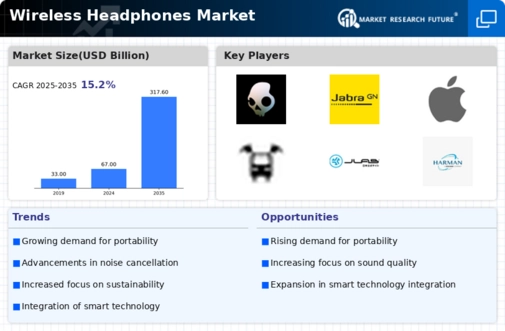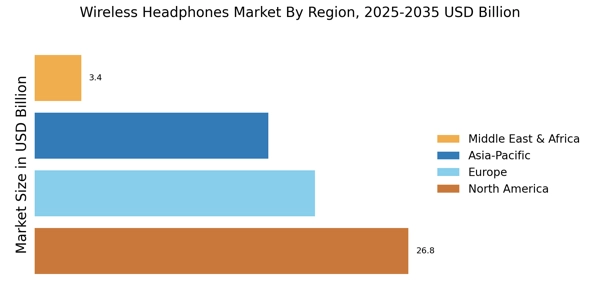Integration of Smart Features
The Wireless Headphones Market is witnessing a transformative phase with the integration of smart features into headphone designs. Features such as noise cancellation, voice recognition, and health monitoring are becoming increasingly prevalent. For instance, the market for headphones with active noise cancellation is projected to grow by approximately 25% annually, reflecting consumer interest in immersive audio experiences. Additionally, the incorporation of health-related functionalities, such as heart rate monitoring and fitness tracking, aligns with the rising health consciousness among consumers. This trend not only enhances the utility of wireless headphones but also positions them as essential accessories for fitness enthusiasts. As technology continues to evolve, the demand for smart wireless headphones is expected to escalate, further driving growth in the Wireless Headphones Market.
Rising Demand for Wireless Convenience
The Wireless Headphones Market experiences a notable surge in demand as consumers increasingly favor the convenience of wireless technology. The proliferation of smartphones and portable devices has catalyzed this trend, with an estimated 60% of headphone users opting for wireless models in 2025. This shift is driven by the desire for mobility and ease of use, allowing users to engage in activities such as exercising or commuting without the hassle of tangled wires. Furthermore, advancements in Bluetooth technology have enhanced connectivity and sound quality, making wireless headphones more appealing. As a result, manufacturers are focusing on developing innovative features such as touch controls and voice assistants, which further enrich the user experience. This growing preference for wireless solutions is likely to propel the Wireless Headphones Market to new heights in the coming years.
Expanding Entertainment and Gaming Sectors
The Wireless Headphones Market is significantly influenced by the expansion of the entertainment and gaming sectors. With the increasing popularity of streaming services and online gaming, there is a growing need for high-quality audio solutions. In 2025, it is estimated that over 70% of gamers prefer wireless headphones for their gaming experiences, citing the freedom of movement and superior sound quality as key factors. This trend is further supported by the rise of esports and virtual reality gaming, which demand advanced audio technology for an immersive experience. Manufacturers are responding by developing headphones specifically tailored for gaming, featuring low latency and surround sound capabilities. As these sectors continue to thrive, the Wireless Headphones Market is poised for substantial growth, driven by the demand for enhanced audio experiences.
Growing E-commerce and Online Retail Channels
The Wireless Headphones Market is experiencing a paradigm shift due to the rapid growth of e-commerce and online retail channels. In 2025, it is estimated that online sales will account for over 50% of total headphone sales, reflecting changing consumer shopping behaviors. The convenience of online shopping, coupled with the ability to compare products and read reviews, has made it the preferred choice for many consumers. Additionally, the rise of social media marketing and influencer partnerships has further propelled online sales, as consumers are increasingly influenced by online recommendations. This shift towards e-commerce is likely to continue, providing manufacturers with new opportunities to reach a broader audience. As a result, the Wireless Headphones Market is expected to benefit from this trend, with online retail becoming a dominant force in driving sales.
Increased Focus on Aesthetics and Personalization
The Wireless Headphones Market is increasingly characterized by a focus on aesthetics and personalization. Consumers are not only seeking functionality but also stylish designs that reflect their personal tastes. In 2025, it is projected that nearly 40% of consumers prioritize design when selecting wireless headphones, indicating a shift towards fashion-forward audio accessories. This trend has prompted manufacturers to collaborate with designers and influencers to create unique and visually appealing products. Additionally, customization options, such as interchangeable ear cups and color choices, are becoming more common, allowing consumers to express their individuality. As the market evolves, the emphasis on aesthetics and personalization is likely to play a crucial role in shaping consumer preferences within the Wireless Headphones Market.

















Leave a Comment